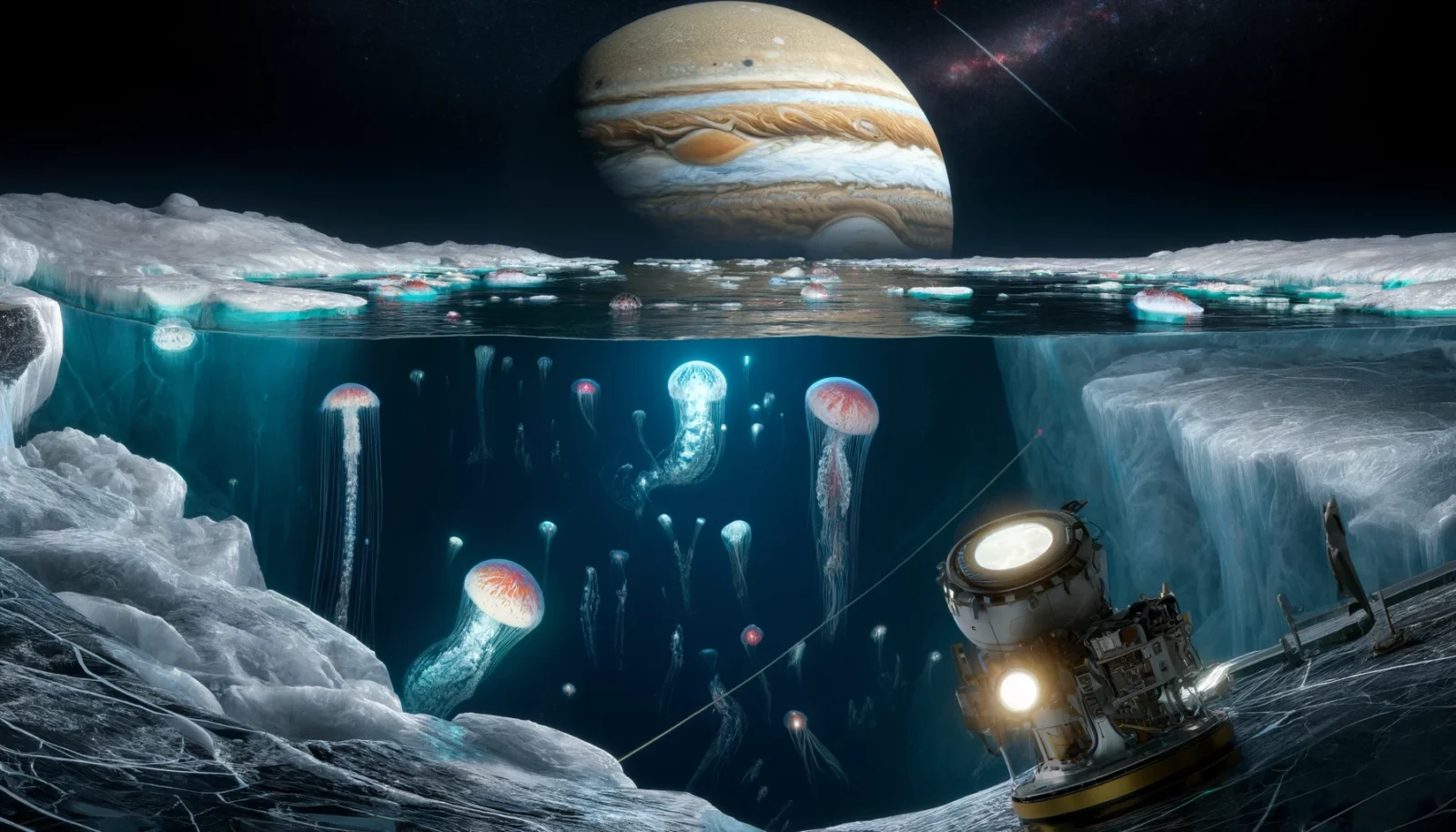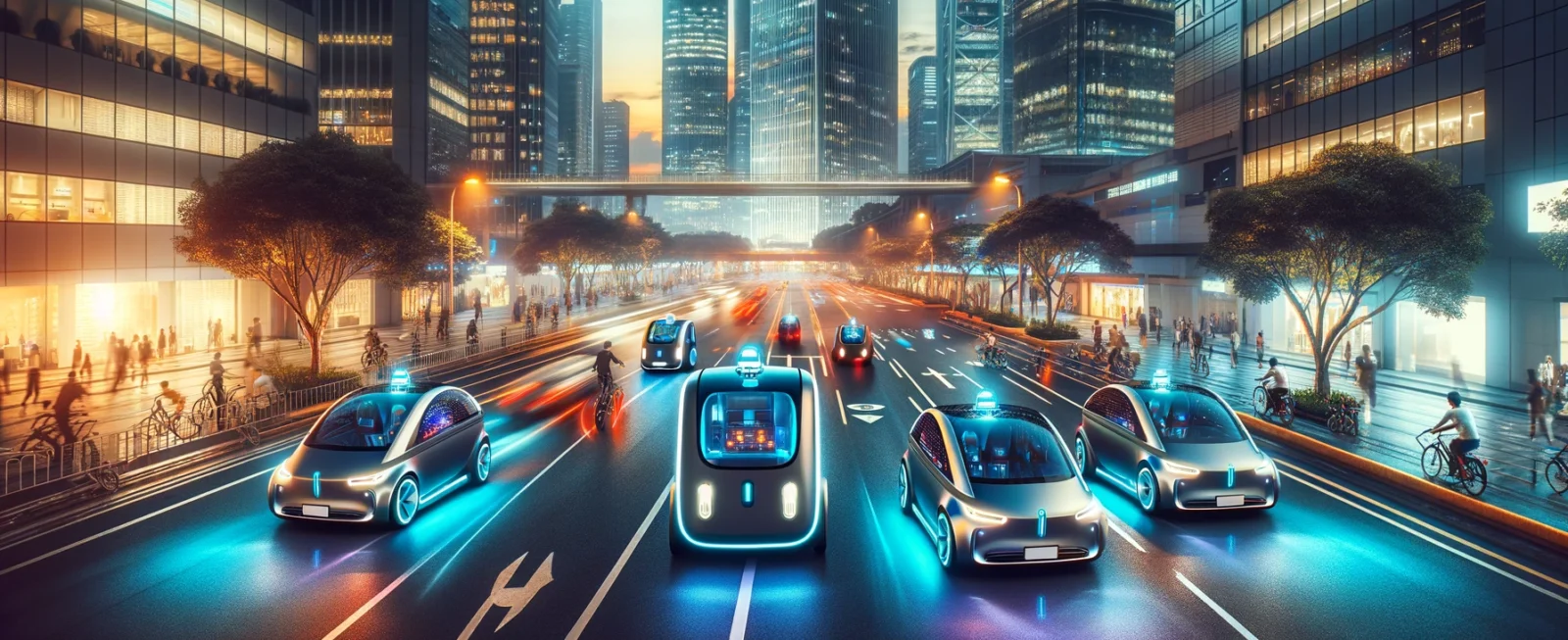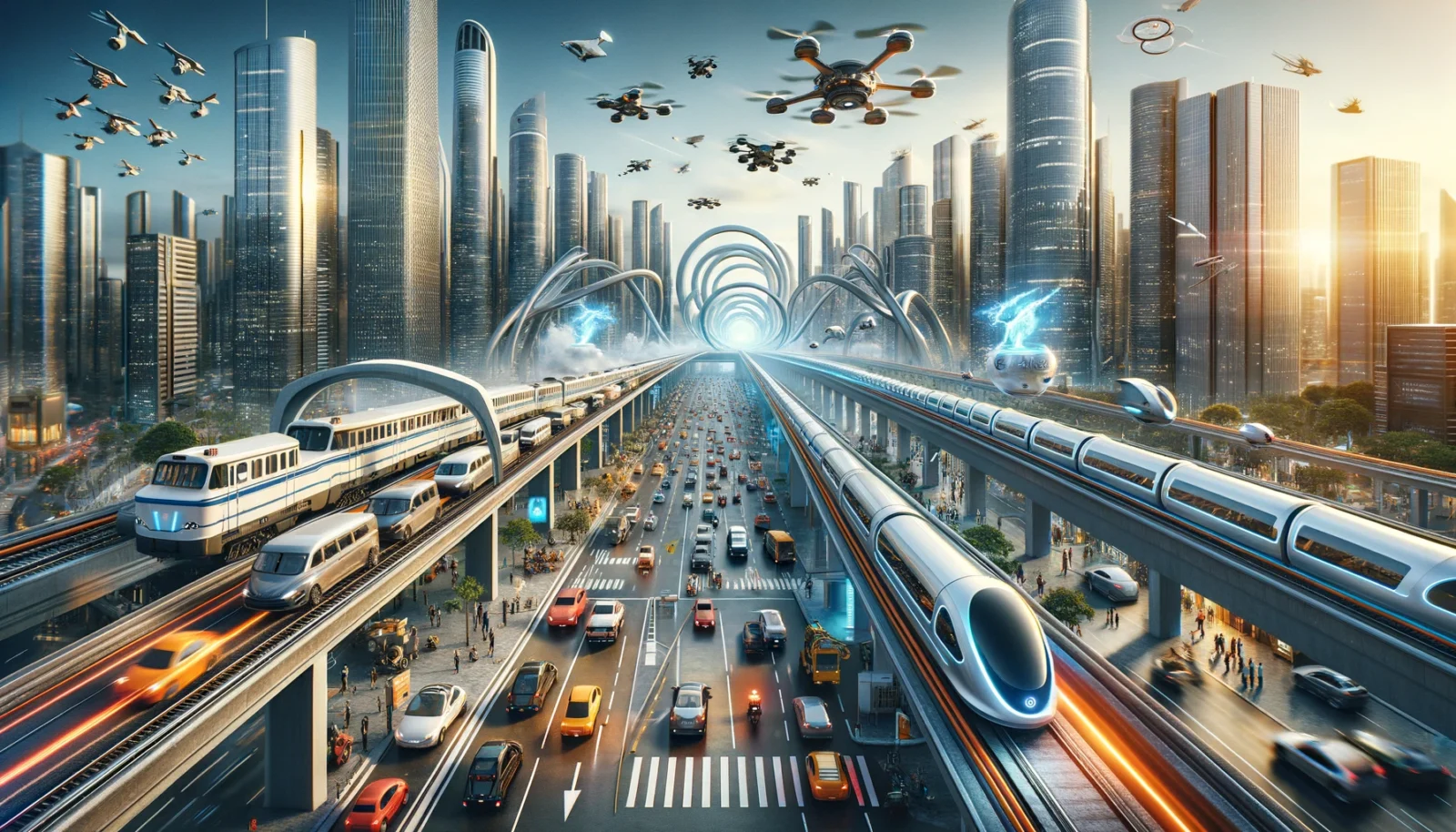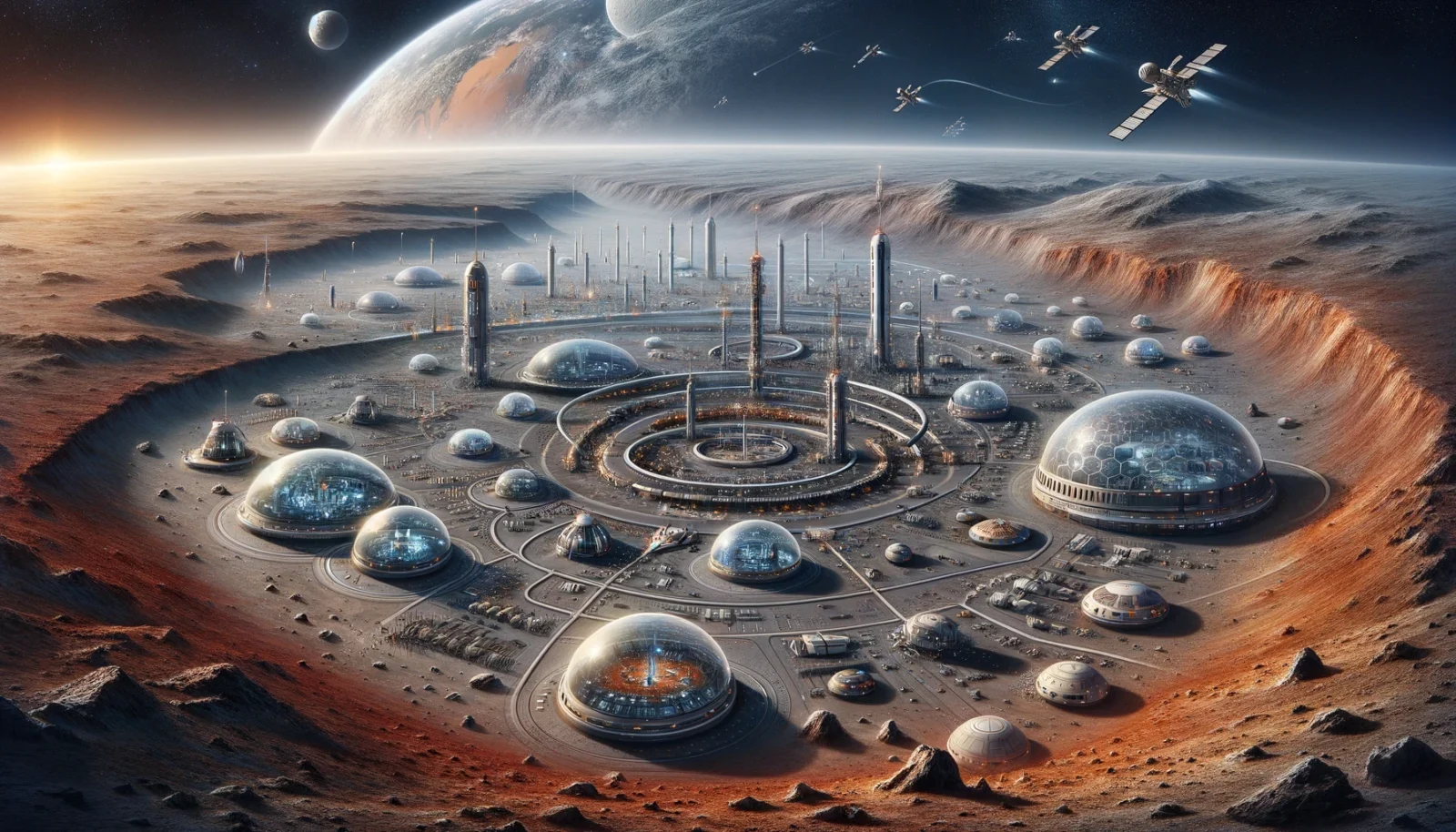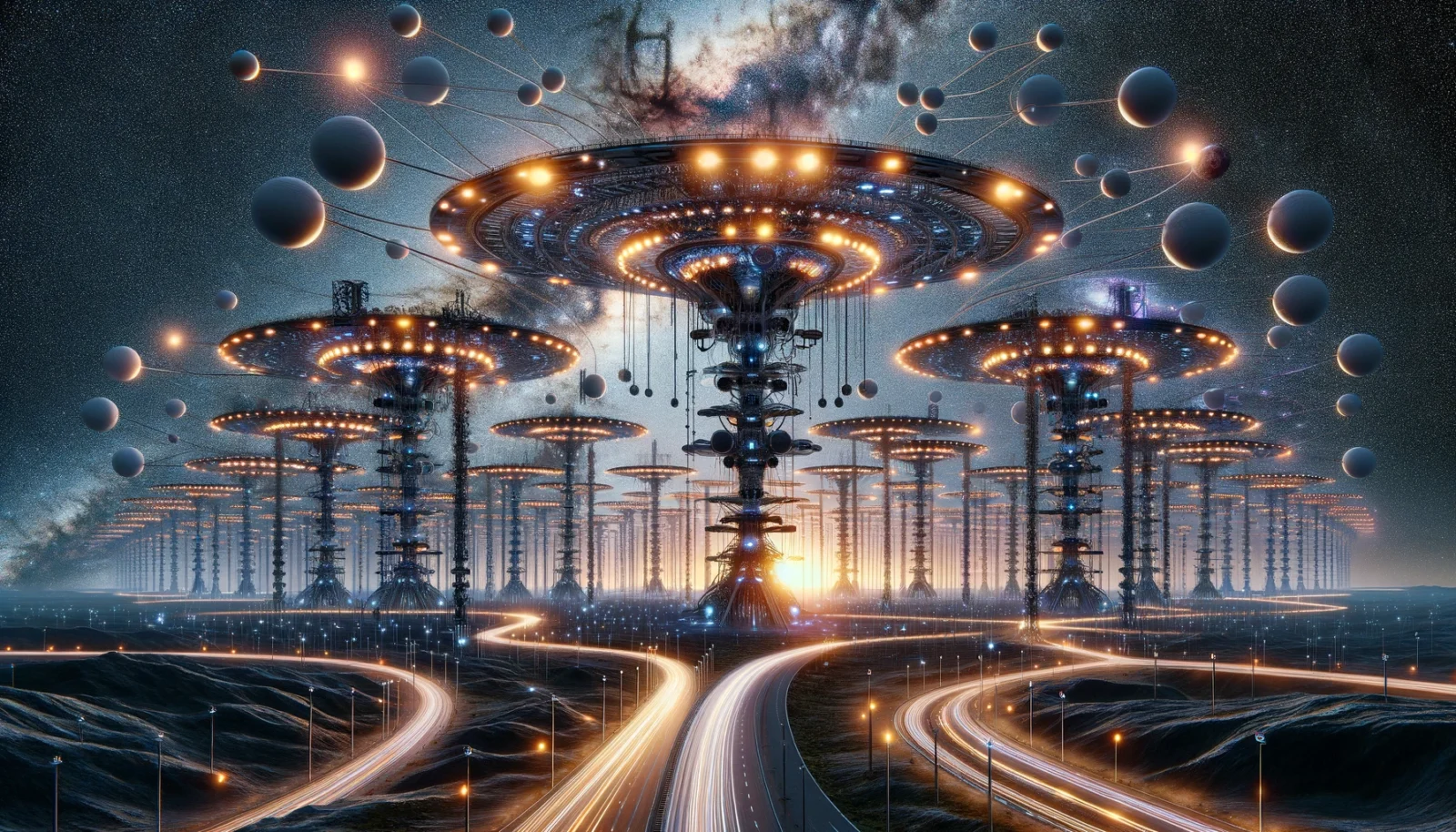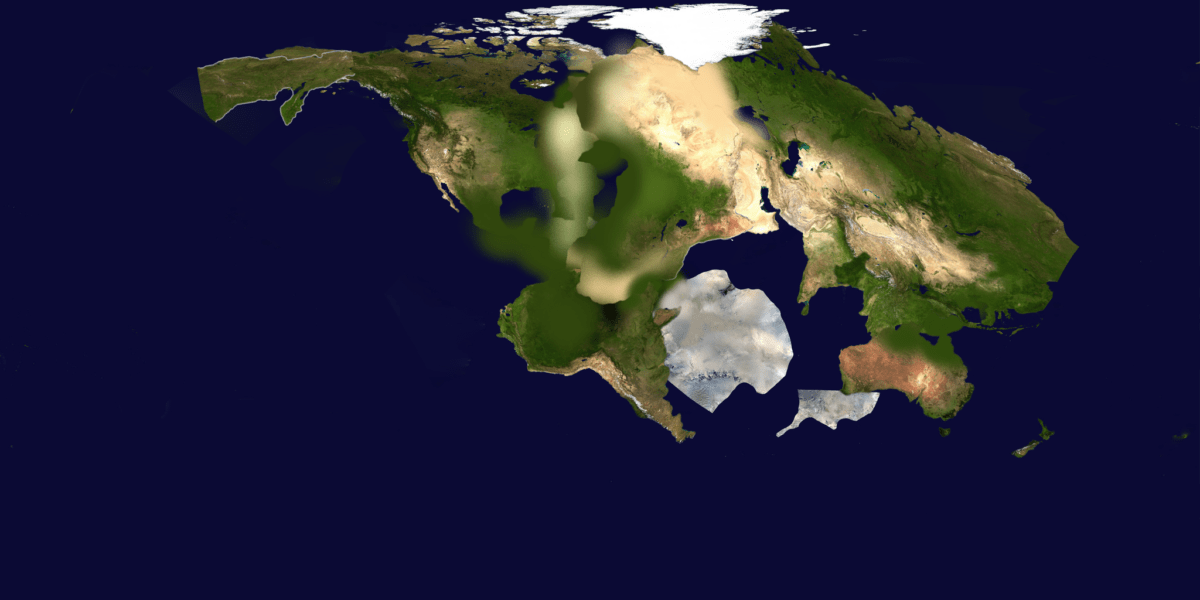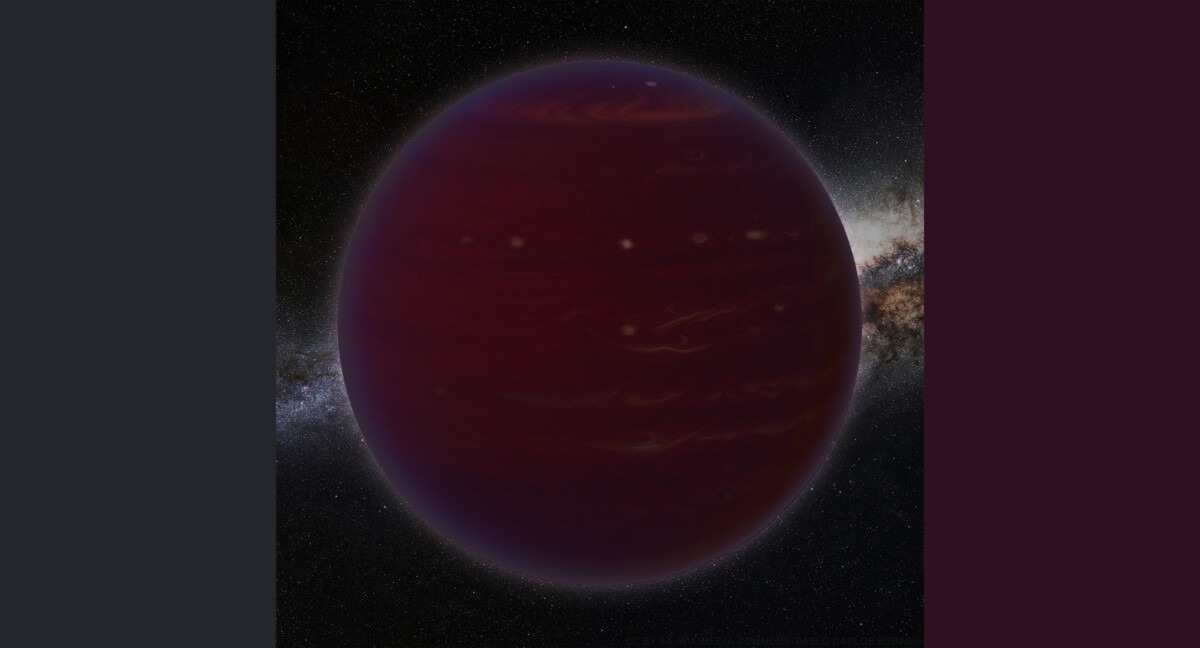Future Predictions
Futurism: Understanding the future can bring clarity to your life now. For example, understanding that we have a new North Star every 13,000 years is interesting, and the fact that we’ll have 100% all new constellations within just one million years helps you to see that astrology is pure junk science, speculative and irrational. The more you know, the better you can live a fulfilling life filled with truth. These potential future predictions are some of the more interesting predictions. Each one indicates verified or speculative and an Idea of Ideas indicator on empirical, rational, or irrational. Sometimes qualifiers are added, as in “Well Verified” or “Somewhat Speculative,” etc.
Futurism
By 2025-6, closed-loop life support systems will be deployed for real-world application aboard the International Space Station (ISS). These systems are designed to recycle and regenerate life-supporting resources like air and water, reducing the need for resupply missions and improving the sustainability of long-duration space missions. This initiative marks a significant advancement in space habitation technology, aimed at supporting future endeavors in more isolated and extreme environments such as deep space or planetary bases.
Analysis: The testing of these closed-loop systems on the ISS serves as a critical benchmark for assessing the viability of sustainable life support in space. Success in this domain could lead to more autonomous space habitats, crucial for the success of future Mars missions and beyond. This period is pivotal as it coincides with increasing international interest in space exploration and the growing involvement of private sector companies. The outcomes of these tests could influence the design and operation of future space habitats, making them more self-reliant and efficient.
By 2028, the Lunar Gateway space station will be orbiting the moon with people on it, during the Artemis IV mission. The advanced life support systems are slated to be integrated into the infrastructure of the Lunar Gateway and employed during Artemis program missions. These systems are part of NASA’s broader strategy to facilitate prolonged human presence on the Moon, providing critical life support functions such as air purification, water recycling, and waste management on both the Gateway and lunar surface habitats. The integration of these technologies is intended to test and prove the feasibility of long-term extraterrestrial habitation, setting the stage for future manned missions to Mars.
Analysis: The Artemis missions are a series of ongoing lunar missions run by NASA. The first Artemis mission was completed in 2022, when an uncrewed test flight orbited and flew beyond the Moon. The integration of advanced life support systems into the Lunar Gateway and Artemis missions represents a significant stride in the roadmap towards sustainable lunar colonization and further planetary exploration. This period of technological implementation and testing is crucial for developing the necessary infrastructure to support human life in extraterrestrial environments over extended periods.
Image above is more of an imagined future. The following is closer to what it will look like:

The world will witness a pivotal moment in computing history as quantum computers achieve “quantum supremacy,” solving problems that were previously unsolvable by classical computers. This breakthrough will herald a new era in fields such as cryptography, material science, and artificial intelligence. With these performance levels, quantum computing will revolutionize industries, leading to advancements in drug discovery, optimization of logistics, and enhanced climate modeling. This technological leap will reshape our understanding of the universe.
Analysis: The concept of “quantum supremacy” was first demonstrated by Google in 2019, but questions remain. A more definitive and widely accepted demonstration will spark a major revolution by 2027. The range reflects the widespread adoption and application of quantum computing in various industries.
My Strategy:
Invest in RGTI, IONQ, QBTS stocks at 30 day lows through 2027.
Invest in the big boys at 5 day lows: NVDA, MSFT, GOOGL, etc.
The barrels per day of oil used by humanity have been on the rise since its discovery in the mid-19th century. In 1950, the world consumed approximately 10 million barrels of oil per day. This figure rose significantly to about 60 million barrels per day by 1980 and further to around 75 million barrels per day by 2000. In 2019, just before the pandemic, global oil consumption peaked at about 99.7 million barrels per day. During the pandemic, consumption dipped, but it rebounded quickly. By 2023, global oil consumption reached approximately 102.21 million barrels per day, and it is expected to continue rising until around 2029, when it is projected to peak at about 105.7 million barrels per day. From this peak, oil consumption is anticipated to enter a gradual terminal decline. This plateauing of oil demand marks a significant turning point in the global energy narrative.
Analysis: The reference year 2029 is significant due to a convergence of technological, economic, and environmental factors. The rapid growth in electric vehicle adoption, improving fuel economy standards, and an increasing emphasis on renewable energy are collectively reducing the reliance on fossil fuels. Additionally, geopolitical factors and policy changes aimed at reducing carbon emissions are accelerating this transition. While the IEA’s forecast is for a peak in 2028, demand for oil in sectors like petrochemicals and aviation will remain robust. Therefore, I’m predicting the tipping point will occur one year later, with a fudge factor of +/- 2 years.
My Strategy:
Invest in DUG inverse oil ETF at 30 day lows through 2035.
Invest in ICLN and CNRG solar ETFs at 30 day lows through 2035.
Invest in NEE and ENPH renewable stocks at 30 day lows through 2035.
Do not short large oil as they have the money to retool.
Neural interface technology advancements will enable seamless human-AI integration. These AI companions will provide real-time information access, language translation, and enhanced cognition.
Analysis: These interfaces have already shown promise in helping individuals with paralysis regain movement, offering the potential for broader applications, including helping people walk again. Early adoption in these specialized medical fields will lay the groundwork for general acceptance by a large segment of the population. By 2030, we can expect the technology to have matured enough for widespread use. Companies like Neuralink are making significant progress in developing brain-machine interfaces, aiming for practical applications by 2035. Despite their benefits, concerns about privacy, dependency, and a potential digital divide between those with and without these technologies will emerge.
Perhaps someone will coin a new nickname for those embracing neural interfaces, perhaps something like “Symbionts.” Other “current” nicknames for BCIs include AI companions, neural interfaces, and brain-machine interfaces (BMIs).
My Strategy:
Invest in ABT, MDT, BSX stocks at 30 day lows through breakthrough adoption, about 2029.
Invest in the big boys at 5 day lows: NVDA, GOOGL, MSFT, and META.
(Wildcard, Not public: Neurolink)
In 2030, NASA’s Europa Clipper arrives at Jupiter, ready to embark on an unprecedented exploration of Europa, one of the most intriguing moons in our solar system. This mighty spacecraft, equipped with an arsenal of cutting-edge instruments, will perform a series of daring flybys, meticulously mapping Europa’s icy crust and peering deep into its subsurface ocean. Clipper’s advanced radar will be able to penetrate the ice, measuring its thickness and potentially revealing hidden pockets of water. Sophisticated spectrometers will analyze the composition of Europa’s thin atmosphere, searching for biosignatures – chemical signatures that could hint at life beneath the ice.
The data collected by Clipper will be instrumental in answering the question that has captivated scientists for decades: does life exist on Europa? With a vast ocean of liquid water, the potential for energy sources, and a protective icy shell, Europa offers all the key ingredients for a habitable environment. While giant, bioluminescent creatures might be out of the picture for now, Clipper’s findings could reveal a hidden world teeming with microbial life. Imagine jellyfish-like organisms drifting through the currents, or heat-loving microbes thriving around hydrothermal vents on the ocean floor. The possibilities are as vast and captivating as the ocean itself, and with Clipper leading the way, we are on the verge of unraveling Europa’s secrets.
In the coming decades, and I predict as soon as 2034, scientists will successfully deploy gene editing technologies like CRISPR to essentially cure diabetes.
Analysis: With gene editing therapies like the treatment for sickle cell already approved by the FDA and in use worldwide, it’s not a matter of if, but when. The rapid development of COVID-19 vaccines using genetic editing technology in 2020 demonstrated the power of this approach. The global success and acceptance of these vaccines have paved the way for further innovation. Given the high priority of diabetes, I predict it will be a key target. Hence the aggressive timeline of within a decade.
For type 2 diabetes, researchers have identified genetic targets like the GCK and HNF1A genes, which play critical roles in monogenic forms of diabetes, including MODY (Maturity Onset Diabetes of the Young). Specifically, they target the INS gene, responsible for insulin production, and the SLC30A8 gene, linked to glucose regulation and insulin secretion. Additionally, efforts focus on enhancing insulin sensitivity and secretion through modifications in genes like TCF7L2 and PPARG. This approach aims to treat existing diabetes and engineer genetic resistance against the disease in high-risk populations.
For Type 1 diabetes, advancements focus on editing immune system genes to prevent the autoimmune destruction of insulin-producing beta cells. Through genetic testing, doctors can identify individuals with specific variants of genes like HLA-DR3, HLA-DR4 (particularly in white people), and HLA-DR7 (in African Americans) that increase susceptibility to the disease. CRISPR is then used to precisely edit these genes in immune system cells, potentially reducing their ability to mistakenly attack insulin-producing cells in the pancreas. This approach will be most effective when combined with other preventative measures to create a comprehensive strategy for stopping type 1 diabetes before it starts as well as largely reversing its effects for the affected.
Human presence on Mars will transition from science fiction to reality with the successful establishment of the first permanent Martian colony.
Analysis: While initial crewed missions to Mars could potentially occur by 2029 or early 2030s, achieving a fully self-sustaining, permanent colony will take a bit longer. While 2033 is a bit overly ambitious, it is possible. A more realistic timeline for a sustainable colony is by 2039, but very likely by 2045.
Companies like SpaceX are already targeting an early timeframe. Even the United Arab Emirates’ plan to establish a settlement on Mars, well, by 2117, but that goal brings a certain reality to the project. NASA’s current plans to return astronauts to the lunar surface in 2024 and establish a sustainable presence on the lunar surface by 2028 also bring this project to the forefront. NASA’s goal it to send humans to Mars in the 2030s supporting the prediction of self-sustaining space exploration station by 2039.
This is the self-driving EV taxi tipping point. The year EV taxis outnumber individually owned vehicles world wide. While individually owned vehicles will likely be a part of society forever, nearly everyone owning at least one is unsustainable over the long-term. A key point in this journey into the future is the year that self-driving EV taxis outnumber individually driven vehicles.
A Mobility-as-a-Service (MaaS) vehicle is an autonomous, electrically powered car designed to transport passengers without the need for a human driver. Equipped with advanced sensors, cameras, and artificial intelligence systems, these vehicles navigate roads, obey traffic laws, and respond to dynamic driving conditions autonomously. Primarily powered by electric batteries, they offer a sustainable alternative to traditional taxis by reducing emissions and minimizing environmental impact. As part of a broader shift towards smarter urban mobility solutions, self-driving EV taxis aim to enhance the efficiency, safety, and accessibility of public transportation systems.
By 2045 or so, we’ll reach a tipping point where 60% of the meat consumed is plant-based and lab-grown meats. By this date, the quality will exceed animal farming and be cheaper. The key to this tipping point is that the quality will be more consistent, taste as good as the best meats, but cost less than the cheapest meats. By 2100, over 90% of meat consumed will be plant-based or lab-grown meats.
Analysis: The choice of 2045 as the tipping point for this dietary transformation is grounded in several converging trends. The acceleration of technological advancements in food science is expected to continue, making alternative meats more appealing and accessible. Secondly, the trend of young people embracing it combined with the death of set-in-their-ways elder, will cascade the trend. Thirdly, the investors in the stock market will run from meat-based companies causing a collapse in the industry similar in impact to the tabacco industry. Forthly, the intensifying impact of climate change motivates stronger global regulatory actions and shifts in public sentiment towards more sustainable consumption practices. By 2100, we will have had three plus full generations of transition and adoption. The eating of slaughterhouse meats will be limited to the rich and esoteric and largely frowned upon by society.
After millennia of myth-based narratives, humanity finally embraces a unified origin story grounded in compelling scientific evidence. By 2080, the scientific understanding of our emergence will become universally accepted. This transformation began in the early 21st century with reforms in science education, increased public awareness, and the integration of empirical evidence into cultural narratives. As the decades progressed, societies around the world adopted this scientifically accurate story of human origins, reconciling it with traditional beliefs and fostering a deeper appreciation for our shared history. Religions evolve too, as they always do. They embrace the empirical story and focus their efforts on intertwining scientific understanding into their stories and exploring and explaining the unknown and unknowable. By mid-century, this narrative will permeate all aspects of education, media, and public discourse, culminating in a semi-global consensus. This unified empirical origin story will serve as a foundation for cooperation, innovation, and a shared vision for the future.
Analysis: The journey to a unified origin story is rooted in the increasing accessibility of scientific knowledge and the growing emphasis on critical thinking. As global education systems prioritized empirical evidence and rational inquiry, the scientific narrative of human origins will gain traction. Influential public figures, media, and technological advancements will play crucial roles in disseminating this knowledge, making it relatable and engaging for diverse audiences. This shift will be further supported by the reconciliation of scientific and traditional narratives, allowing for a more inclusive and tolerant understanding. People will no longer ignore empirical evidence, and personal beliefs will transition from focusing on rewriting reality to embracing reality and exploring the unknown and unknowable. While we can figure out the currently unknown, by definition, we can never know the unknowable.
By 2090, the integration of androids into everyday human life may shift from the realms of science fiction to everyday reality. This shift will be driven by advancements in artificial intelligence, robotics, and societal acceptance. As we gaze into the next half-century, the path to achieving a 1:1 ratio of humans to androids presents both groundbreaking opportunities and formidable challenges. The odds of achieving a 1:1 ratio hinge on these critical factors, with the potential for either a harmonious integration or a conflicted coexistence shaping the late 21st century.
Speculative Timeline:
2040 to 2050: This period might see a surge in the production and implementation of androids in sectors where precision, efficiency, and risk management are paramount—such as healthcare, manufacturing, and disaster response. Governments begin to establish frameworks for android rights and responsibilities, sparking debates on ethics and the nature of intelligence.
2050-2060: As human lives become more enriched by this resource, android technology becomes more affordable and widespread, reaching into homes as caretakers and companions. By 2065, major urban areas report that androids make up approximately 25% of their operational workforce. This period also marks the onset of significant pushback from human labor groups, leading to the first global conference on Human-Android Economic Coexistence.
2070-2080: Social Normalization and Backlash. The android presence in personal and social settings becomes normalized. However, this integration is not seamless, as societal divisions emerge over android rights. The “Human First” movement gains momentum, advocating for strict limitations on android capabilities and roles. Simultaneously, a counter-movement pushes for complete android autonomy.
2080-2090: Technological Harmony or Discord? Breakthroughs in android emotional intelligence occur, allowing for deeper human-android relationships. These relationships challenge existing social norms and provoke a reevaluation of what it means to be “alive.” Androids start to participate in creative and decision-making processes, leading to joint human-android innovations.
2090: The Tipping Point. By 2090, the global ratio of androids to humans is approaching 1:1. This equilibrium brings new governance challenges, as androids seek—and in some regions, achieve—legal personhood. Economies adapt to a new labor paradigm, emphasizing creative and interpersonal skills where humans excel.
My Strategy:
None, too far out, but watching Optimus, a division of TSLA.
Also watching: SFTBY, HMC, TM, SSNLF, HYMTF
Likely to start investing by 2030 after reevaluating leaders.
This estimate aligns with the medium-variant projection from major demographic studies like those conducted by the United Nations, which predict that the population could be between approximately 9.3 billion and 11.3 billion by the end of the century.
Kardashev scale: Type I | Type II | Type III
(A framework introduced by the Soviet astronomer Nikolai Kardashev in 1964.)
Essentially 100% renewable and/or clean energy: I have expanded Type I from merely capturing Earth’s energy to producing an equivalent amount of energy, focusing on renewable and clean sources. The goal is to match the potential energy output from all sources but achieved entirely through renewable or clean energy methods. While the focus is on renewable and clean energy, allowances might exist for minimal uses of traditional fuels, such as preserving vintage cars for cultural purposes. The broadening of the definition from merely capturing to producing energy enables advances in technology. So, while the original definition focused only on known renewable energy sources and technology imagined at the time, this new approach enables potentially revolutionary methods such as advanced nuclear fusion, artificial photosynthesis, or other innovative means to generate power. This not only encompasses direct energy capture from natural sources but also the synthesis of new energy forms, making energy management more versatile and robust.
According to the original definition, this level of civilization can harness all the non-renewable energies like fossil fuels as well as all renewable sources like solar, wind, geothermal, and other natural energy sources. According to physicist Michio Kaku, achieving Type I status is a multi-millennial project that includes not only utilizing these energy resources but also theoretically controlling weather patterns and seismic activities. The original definition also proposed building cities on the ocean.
Reach: Homo sapiens expand to fully utilize Earth’s surface, including significant populations living underground and in orbit. Our reach extends to the Moon and Mars, where we occupy their surfaces and orbits. Agreements among diverse human groups facilitate genetic manipulation, allowing controlled evolution of Homo sapiens. This ensures that all genetic changes are consensual across all factions, giving us complete control over our evolutionary path.
Effects: No matter how we get to Type I, energy worries no longer exist and the energy needs of individuals are essentially free. At this stage, we have so much energy that no one on Earth pays to move their personal vehicles or power their home. Perhaps businesses will pay a very small fee to run their businesses up to a certain point. Beyond that, energy would cost more, but the energy needed for most entrepreneurial innovation would be within reach. This would include the energy needed to build and use vehicles around the globe. These vehicles would likely be built and maintained by AI-controlled robots. While costing a bit more, this would include many types of projects including building cities on the ocean, vehicles moving to and from the moon and space stations, and to and from Mars.
Estimates for when humanity might achieve Type I status—or its equivalent—typically range from the next 100 to 200 years. Michio Kaku suggests that we might reach Type I status within the next few centuries. The progression towards this status is evident in our increasing global energy consumption and advances in renewable energy technologies.
Biological immortality, or negligible senescence, is not invincibility against accidents or violence, but rather the cessation of aging and the ability to prevent or cure all diseases, including genetic disorders. Essentially, it involves maintaining the body and its functions in a youthful state indefinitely. The key components of biological immortality include gene editing, disease cure and prevention, and aging process interruption.
I think we’ll attain biological immortality by about 2200 because rapid advancements in gene editing, disease treatment, cellular repair, and aging research, combined with the convergence of AI, biotech, and nanotech, will lead to a comprehensive understanding and control of human biology, enabling the cessation of aging and the prevention or cure of all diseases, including genetic disorders, thereby achieving negligible senescence and biological immortality.
By the year 2200, major world religions will have fully integrated empirical observation into their doctrines, acknowledging the importance of scientific understanding in exploring the mysteries of existence. This shift will mark a profound transformation in religious thought, where spiritual narratives are continuously updated to reflect the latest scientific discoveries. This new era of empirical spirituality will see religious teachings embrace the unknown not as a gap to be filled by faith alone but as an invitation to explore and understand through both scientific inquiry and spiritual contemplation. Religions will increasingly focus on harmonizing empirical evidence with spiritual beliefs, leading to a more enlightened and unified approach to understanding existence.
Analysis: The reference date of 2150 CE is chosen based on current trends in the dialogue between science and religion. Over the past century, there has been a growing movement within many religious communities to reconcile scientific discoveries with spiritual beliefs. For instance, the acceptance of the Big Bang theory by the Catholic Church and the increasing number of religious leaders advocating for environmental stewardship based on scientific data reflect this trend. By 2150, it is reasonable to expect that these dialogues will have matured significantly, laying the groundwork for a full integration of empirical observation into religious frameworks by 2200. This timeline is supported by the accelerating pace of scientific discovery and the corresponding willingness of many religious traditions to adapt and evolve in response to new knowledge.
The estimate of 300 years from now, give or take a century, marks a speculative point when we might reasonably expect a response from extraterrestrial life. This prediction takes the centennial anniversary of the Arecibo message into account, a significant milestone in human history. It was the first high-powered, targeted broadcasts sent into space. As our signals continue to radiate outward and our listening technologies improve, the coming centuries represent a hopeful window for making the first contact, according to the complex calculations inspired by the Fermi Paradox. It takes into account the vastness of space, signal decay over immense distances, and the relatively short time humans have been sending out detectable signals. It also factors in variables like the advanced civilizations’ emergence, technological capabilities, and the likelihood of their signals or ours traversing the vast interstellar distances successfully.
Prior to us sending out interesting light signals, the chances of extraterrestrial life deciding to visit us was small. Within 100 light-years, it’s estimated there might be 100,000 planets. Space is vast so making such a long journey without seeing interesting light or another “signal” is not likely. All this means, the longer we send out light, especially in the form of radio waves and directed communication, the better the odds we can make contact.
The population of humans not living on land will exceed the population living on land. The non-surface population will live in floating cities, underground, on the bottom of the ocean, in orbiting space stations around Earth, the Moon, and Mars, as well as on the surfaces of the Moon and Mars. Potentially, there will also be populations living underground on Mars and the Moon if it turns out that living below the surface is more practical. There will likely be a few floating space stations between Earth and the Moon, and between Earth and Mars, and perhaps a few beyond Mars.
Analysis: As humanity approaches a population of 10.5 billion by 2100, we will begin to seriously explore how to fully maximize Earth and local space. The urgency will be driven by longer life and technological advancements that make our current AI aspirations look primitive. In preparation for the challenges of building permanent floating space stations beyond Mars, humanity will construct massive floating cities and underground cities, followed soon after by aquatic cities on the ocean floor. Simultaneously, we will perfect space station technology, including orbiting, surface, and underground habitats focusing on the Moon, Mars, and its two moons.
By the time humanity reaches biological immortality by about 2200, life in these exotic areas will become “normal.” People will die mainly from accidents or a refusal of medical treatment. They will live large portions of their first century in ocean-floating cities, underwater stations on the seafloor, and space stations. Starting in about four generations, some people will be born, raised, and die without ever having seen land on Earth. Their reality will be shaped by their environment, whether it is one of the ocean cities, an aquatic station on the sea floor, or a space station within view of Earth.
By 2350, within another ten generations or so, our bond to terrestrial Earth will be replaced with a bond to where they were born. As always, some people will migrate from one place to another for various reasons.
Viewpoint: The time from now to then will feel as distant as the Middle Ages feel to us today. Future generations will look back at us in the same way we look back at figures like Michelangelo, Copernicus, and William Shakespeare.
Vacations: Options for yearly vacations will include traditional natural destinations like forests, beaches, and islands, as well as entertainment-based destinations like Las Vegas, Disneyland, and Paris. If you live in one of the orbiting space stations or on the Moon, you will have access to your own Disneyland and Las Vegas attractions. Someone growing up in one of the aquatic stations on the ocean floor might venture yearly to the surface.
Beyond yearly vacations, once-in-a-lifetime adventures lasting nearly a year will include experiences like a Martian adventure, where you travel to the Moon, visit the large space stations between Earth and Mars, and explore the space stations orbiting Mars and its moons, Phobos and Deimos. You could then either visit the surface of Mars and/or its moons or venture out to the large space stations established beyond Mars. Naturally, your choice for a once-in-a-lifetime trip will depend on where you grew up. If you grew up on Mars or one of the distant space stations, your once-in-a-lifetime vacation might be a trip to Earth.
Timeline:
2025-2035: Initial Martian and Lunar Bases. Space Tourism Begins.
2035-2050: Expansion of Orbital Stations. Underwater Habitats.
2050-2100: Space Station Network. Underground Cities. Increased Non-Surface Population.
2100-2150: Advanced Lunar and Martian Colonies. Permanent Underwater Cities.
2150-2200: Orbital Habitats. Interplanetary Trade and Travel. Cultural Shift.
2200-2250: Massive Space Stations. On-water, underwater, and underground cities.
2250-2300: Population Growth. Advanced Technologies.
2300-2350: Self-Sustaining Habitats. Interplanetary Colonization.
2450: Non-Surface Population Tipping Point.
The transformation or emergence of beings that have transcended current human biological and cognitive limitations. This could be achieved through advanced genetic engineering, cybernetic enhancements, or the development of entirely new forms of consciousness within AI systems. A group of our descendants are likely to attain God-like abilities over matter and energy at a level of technological and scientific mastery that allows for manipulation of the physical world in ways currently considered impossible. This could include control over fundamental forces, creation of life, terraforming planets, manipulating quantum states, and potentially even affecting the structure of space-time. The start of this process has already occurred, for example with CRSPR technology, and post human evolution could start much sooner, or perhaps much later.
Analysis: Based on the exponential pace of technological advancements, particularly in fields like genetics and artificial intelligence. We will achieve significant milestones sooner due to breakthroughs in understanding and applying biological and computational principles.
By 3825, humanity will embark on terraforming Mars, a monumental task that will take decades, if not centuries, to complete. The primary objectives will be to create a livable atmosphere, oceans, and transform the top 18 inches of Martian soil into a fertile ecosystem, a stark reminder of the delicate biosphere on Earth. This process will involve introducing genetically engineered microorganisms, plants, and animals into suitable ecotopes, carefully crafted niche environments.
Cutting-edge technologies, including advanced robotics, artificial intelligence, biotechnology, and possibly nanotechnology, will be crucial to this endeavor. Autonomous robots will release greenhouse gases, followed by the creation of a breathable atmosphere using advanced gas processing technologies. Self-reproducing robots may build machines that generate an atmosphere, and colossal tree planters could introduce genetically modified organisms that thrive in the harsh Martian environment.
As the planet becomes more hospitable, human settlers will arrive, bringing innovative solutions for managing the Martian environment, such as climate engineering and geoengineering. Over the next thousand years, Mars will transform into a thriving hub of human activity, complete with sprawling cities, lush ecosystems, and a vibrant culture. This technological leap, combined with sophisticated climate engineering techniques, will set the stage for the gradual rebirth of Mars, turning the red planet green.
Analysis: Setting the commencement of terraforming 1,800 years into the future allows ample time for humanity to perform and adjust the necessary societal, ethical, and environmental analyses, ensuring a careful and thorough approach to this monumental task. This reference point is admittedly a guesstimate, but reflects the immense scale of the challenge and is based on a our current technological trajectory. It relies on the continued rapid progress in fields like space exploration, renewable energy, biotechnology, genetics, and AI. Terraforming is not a one-time project but an ongoing transformation. Even after jumpstarting the Martian atmosphere, it would take centuries, perhaps millennia, for the planet to reach a stable and self-sustaining state. During this time, constant monitoring and adjustments would likely be required, ensuring the terraforming process continues on a desired trajectory. At this point, we’ll have two planets, both evolving life on separate evolutionary paths unless genetic modifications are used to keep them aligned.
Kardashev scale: Type I | Type II | Type III
Renewable and clean power output equals our star: I have redefined Type II to shift away from merely capturing the Sun’s energy to utilizing energy sources that produce power equivalent to that of our star. This adaptation moves away from reliance on technologies like the Dyson Sphere and opens the possibility for advanced methods.
Since Einstein’s equation E=mc2 means energy is matter and matter is energy, at this stage we have the ability to go back and forth effiently enough to produce energy equivalent to our Sun. This might mean significant evolving and scaling up of atomic energies, such as fusion energy, antimatter, and the theoretical harnessing of dark energy, which remain largely speculative but represent the frontier of cosmic energy management. Another potentioal path is stellar harvestors. They would function outside of Earth’s orbit and capture and produce renewable energy equivalent to the Sun.
According to the original definition, a Type II civilization represents a monumental leap in technological and energy management capabilities, where a civilization harnesses all the energy output of its parent star. This achievement would likely involve constructing megastructures such as a Dyson Sphere, a theoretical construct designed to encompass a star entirely, capturing most or all of its energy output.
Reach: Homo sapiens spread throughout the solar system, making full use of all planets, moons, and major asteroids, as well as the space between them. This includes exploiting all orbital and revolving forces, surface areas, and populations living underground and under-sea on planets, moon, and larger asteroids. While a broad consensus among human factions maintains genetic consistency across most of the population, renegade groups have diverged, embarking on their own evolutionary paths.
Effects: With energy at planetary levels essentially free, humanity could experience a revolution in its living standards, work, and exploratory capabilities. With this level of access to energy, the entrepreneurial innovation of humanity’s creativity aided by robotics and AI appears nearly unlimited. This abundance of energy would likely spur massive innovations, reshaping economic structures and creating industries that seem like science fiction today. The possibility of interstellar spacecraft and space stations floating in space outside Earth’s orbit, and potentially outside the reach of the solar system. This level of access to energy could extend humanity’s reach beyond our solar system, drastically changing our understanding of space and our place within it.
Furthermore, the widespread availability of such energy could significantly reduce global inequalities, laying the groundwork for a more equitable distribution of resources. As societies become more interconnected through advanced space travel and communication technologies, we might see the emergence of a unified global or even interstellar cultural identity.
Estimates: While traditional estimates for achieving Type II status suggest tens of thousands of years, or even much longer to build a Dyson sphere, focusing on producing equivalent energy rather than capturing all of a star’s output could potentially shorten this timeline to thousands of years. This optimistic scenario relies on exponential advancements in robotics, AI, and energy technologies.
Kardashev scale: Type I | Type II | Type III
Renewable and clean power output equals our galaxy: I have redefined Type III to shift from merely capturing the energy of a galaxy to utilizing energy sources that produce power equivalent to that of our entire galaxy. This adaptation moves beyond the traditional focus on megastructures like Dyson Spheres or Swarms encasing multiple stars and opens possibilities for advanced galactic energy management methods.
Since Einstein’s equation E=mc2 suggests that energy and matter are interchangeable, at this stage, civilizations could theoretically convert galactic matter into energy efficiently enough to produce power on a galactic scale. Using AI-controlled robots with nearly unlimited energy, they could gather materials, reproduce an army of robots, send them to the next source, while finishing up harnessing the current materials. This might include advanced forms of energy production such as harnessing the rotational energy of the galaxy, utilizing the gravitational forces of supermassive black holes, and perhaps the theoretical extraction of energy from dark matter or dark energy, which remain speculative but represent the frontier of cosmic-scale energy management.
According to the original definition, a Type III civilization represents an extraordinary leap in technological and energy management capabilities, where a civilization harnesses the energy output equivalent to that of its entire galaxy. This achievement would likely involve not just constructing but also managing complex networks of energy harvesters throughout the galaxy, potentially linking star systems with vast arrays of energy transmitters and receivers.
This interpretation of the original concept lends credibility to my modifications of Type I and II towards the notion of equivalent energy. At the very least, considering that Type III may involve harnessing energy equivalent to all outputs within a galaxy, my adjustments to Type I and II represent a logical extension rather than a radical departure from Kardashev’s original ideas.
Reach: Homo sapiens extend beyond our solar system to inhabit large, redundant space stations throughout this quadrant of the Milky Way galaxy and around its stars. While agreements among factions have kept most populations genetically similar, advancing as a collective when consensus is reached, interactions—including agreements and conflicts—with renegade groups that have evolved into different species are now commonplace. This includes the occassional major war.
Most scientists believe that evolutionary forces are abundant and common in life throughout the universe, leading many to posit that intelligent life has already evolved and is abundant across the cosmos. If these assertions hold true, this stage of human expansion would likely involve interactions not just with divergent human groups but also with extraterrestrial civilizations. These encounters could range from peaceful exchanges to conflicts, echoing the historical interactions among different Homo species on Earth. Such interstellar interactions, including occasional major wars, might become a regular aspect of life, as humanity navigates the complex dynamics of a galaxy inhabited by multiple intelligent species, each with its own culture, technology, and territorial claims.
Effects: With energy on a galactic scale essentially limitless, humanity could experience unprecedented advancements in living standards, technological capabilities, and cosmic exploration. With this level of access to energy, the possibilities for innovation and creativity could be boundless, likely driving monumental advancements in technology and enabling the development of societies across different star systems. The potential for constructing megastructures, inhabiting and terraforming new worlds, and possibly even manipulating the fundamental forces of the universe could become feasible.
The widespread availability of such energy could lead to a significant transformation in how civilizations view and distribute resources, potentially eradicating energy scarcity and dramatically reducing inequalities across star systems. As societies become interconnected through advanced galactic travel and communication technologies, a unified intergalactic cultural identity might emerge, profoundly changing our understanding of community and cooperation on a cosmic scale.
Estimates: While traditional estimates for achieving Type III status suggest hundreds of thousands to millions of years, focusing on producing equivalent energy rather than capturing all of a galaxy’s output could potentially shorten this timeline.
With the aid of previous advancements, type III might be acheivable in just 10,000 years from now. This relies on exponential growth in previous technologocal advancements. This optimistic scenario relies on exponential advancements in energy, quantum computing, AI, robotics, and other yet-to-be-invented technologies. This envisions a future where energy and our current obstables are not a limiting factor for civilizational development.
Right now Polaris is our North Star. In 13,000 years it will be Vega. The Earth spins as it revolves around the Sun, but the North Pole is always pointing toward the North Star, Polaris. The Earth spins and only wobbles a tiny bit over millennia as it revolves around the Sun, and our Sun revolves around a pretty flat Milky Way galaxy. Our solar system, like a thrown frisbee, stays pretty flat in space. The wobble described above is called the axial precession in scientific terms. That’s the North Pole moving in a small circle when compared to the sky. This axial tilt causes the celestial poles to align closely with specific stars, for now, Polaris in the Northern Hemisphere. The Earth’s wobble, or axial precession, is slow, about 26,000 years per wobble cycle. At about 13,000 years through the cycle, the Northern Star will be Vega, not Polaris.
Geological and astronomical models predict that Earth is due for another glacial period within the next 100,000 years, possibly plunging much of the planet into ice. This event will significantly impact ecosystems, sea levels, and potentially human civilizations, depending on technological advancements and societal adaptations.
The constellations we recognize today will be vastly different in a million years due to what astromers call “proper motion” of stars. This will transform our night sky, creating new constellations from stars that have shifted positions, presenting future astronomers with a completely new celestial map to study. Because of stellar motion, our current Star Catalogue will evolve, making the sky look different, but it will still be filled with stars, as I explain in my End of the Universe Explained article. No current constellation will remain intact. Remarkably, Earth will continue to have a North Star, despite the 26,000-year cyclical wobble of Earth’s poles. Vega served as the North Star 13,000 years ago and will do so again; over a million years, both Polaris and Vega will continue to reprise their roles in this cycle.
We can measure the movement of continents very precisely. Their future locations are a simple exercise in the empirical sciences. Predictive models like “Pangaea Proxima” (sometimes called “Next Pangaea” or “NeoPangaea”) predict the formation of a new supercontinent in about 250 million years, potentially sooner. This model sees “ALL” of Earth’s continents coming together to form a single massive landmass. Perhaps even with South America and Africa coming back together!
If this potential continent forms, it will be similar to the ancient supercontinent Pangaea, which existed about 335 to 175 million years ago during the late Paleozoic and early Mesozoic eras. This massive landmass could dramatically alter global climate patterns, biodiversity hotspots, and even human geopolitical landscapes. This model, the Pangaea Proxima model, is but leading model of several about how the continents will rearrange in the distant future.
The Milky Way and Andromeda galaxies are expected to collide and merge into a single elliptical galaxy. Despite the dramatic nature of this event, the vast distances between stars mean that direct stellar collisions are unlikely.

The death of our Sun is estimated to occur in about 5 billion years. Around this point, life on Earth will become uninhabitable. There will likely be life here right up until there’s not. Most humans will have left the planet many millions of years prior to this point. Also, the merging of the Andromeda and Milky Way galaxies will have started about 500 million years earlier.
In about 50 to 100 billion years, then over tens of billions of years, gravitational interactions with other bodies and the loss of mass by the Sun as it becomes a white dwarf could cause the remaining planets’ orbits, including Earth’s (if it survives the Sun’s red giant phase), to decay or become unstable.
Over an incredibly long timescale, the Sun’s white dwarf remnant could cool enough to become a black dwarf, a theoretical stellar remnant that emits no light. Although speculative, theoretical models give us insight into the lifespan of the Sun as a white dwarf. After transitioning into a white dwarf, the Sun is expected to cool and fade over an extraordinarily long period. It is theorized that, eventually, it will become a black dwarf — a cold, dark stellar remnant that no longer emits significant heat or light. This transformation could take place sometime after 1 quadrillion years — that’s 1,000 sets of a trillion years! Moreover, some estimates extend this timeline by a factor of up to 37, pushing the boundaries of our understanding of stellar evolution and the future of the cosmos. The eventual cessation of white dwarf stars, including our Sun, represents one of the universe’s far future events. However, these estimates are highly speculative, reliant on theoretical models of stellar cooling that project far beyond our current empirical observations. Given that the universe itself is not yet old enough for any black dwarfs to exist, this prediction is rooted more in our extrapolation of physical laws than in direct evidence.
The Lambda Cold Dark Matter model of the universe predicts a Big Freeze. The Big Freeze is projected sometime after 10100 years from now. That’s a set of googol years from now. After billions is trillions then quadrillion. After quadrillions is Quintillion, Sextillion, Septillion, Octillion, Nonillion, Decillion, and finally a GOOGOL. This number is beyond most, let alone this duration of years. It gives you an idea of how long the universe will last. And, if this bothers you, remember, this is a worst case scenario. Read my The End of the Universe Explained for more details.
The heat death of the universe represents the ultimate fate of all matter and energy within the cosmos, according to the second law of thermodynamics. In this scenario, the universe will have expanded to such an extent, and its matter and energy will be distributed so evenly, that no further work can be done, and all dynamic processes cease. The universe reaches a state of maximum entropy, where temperature differences vanish, leaving behind a uniform, cold, and lifeless cosmos.
This transformation is expected to occur on timescales well beyond 10^100 years, a number so vast it dwarfs all conventional measures of time. The concept of heat death emerges from extrapolating known physical laws over unimaginable epochs, leading to a universe devoid of the energy gradients necessary to sustain motion, life, or light.
While the heat death scenario is grounded in the principles of thermodynamics and cosmology, it remains highly speculative due to the extrapolation required and the many unknown variables about the universe’s future evolution. Current models suggest that such a state would mark the end of the observable universe as a dynamic, structured entity. However, this vision of the cosmos’s end is based on our current understanding of physical laws, which may evolve with future discoveries and theoretical advancements.








